transmission TOYOTA iQ EV 2013 Owners Manual (in English)
[x] Cancel search | Manufacturer: TOYOTA, Model Year: 2013, Model line: iQ EV, Model: TOYOTA iQ EV 2013Pages: 444, PDF Size: 7.34 MB
Page 3 of 444

3
9 8
7
6
5
4
3
10
1
2
5-1. Before drivingDriving the vehicle ............. 150
Cargo and luggage............ 159
Vehicle load limits ............. 162
Trailer towing..................... 163
Dinghy towing.................... 164
5-2. Driving procedures Power (ignition) switch ...... 165
Transmission ..................... 171
Turn signal lever................ 173
Parking brake .................... 174
Horn .................................. 175
5-3. Operating the lights and wipers
Headlight switch ................ 176
Windshield wipers and washer ..................... 178
Rear window wiper and washer ..................... 180
5-4. How to charge Normal charging ................ 181
Quick charging .................. 195
Timer charging (normal charging only) ................. 202
5-5. Using the driving support systems
Driving assist systems....... 210
Hill-start assist control ....... 213
5-6. Driving tips Winter driving tips.............. 215 6-1. Using the air conditioning
system and defogger
Air conditioning system...... 220
Remote Climate Control System for EV ................. 228
Rear window defogger....... 232
HWD (Heated Windshield Defroster) ...... 233
6-2. Using the interior lights Interior lights list................. 234• Interior light ................... 234
6-3. Using the storage features List of storage features ...... 236• Cup holders ................... 237
• Bottle holders ................ 237
Luggage compartment features ........................... 239
6-4. Other interior features Sun visors and vanity mirrors ............ 241
Outside temperature display ............................. 242
Power outlet....................... 243
Seat heaters ...................... 244
Assist grips ........................ 246
5Driving6Interior features
Page 149 of 444

149
5Driving
5-1. Before drivingDriving the vehicle ............. 150
Cargo and luggage ........... 159
Vehicle load limits ............. 162
Trailer towing..................... 163
Dinghy towing ................... 164
5-2. Driving procedures Power (ignition) switch ...... 165
Transmission ..................... 171
Turn signal lever................ 173
Parking brake .................... 174
Horn .................................. 175
5-3. Operating the lights and wipers
Headlight switch ................ 176
Windshield wipers and washer ..................... 178
Rear window wiper and washer ............................ 180
5-4. How to charge Normal charging ................ 181
Quick charging .................. 195
Timer charging (normal charging only) ................. 202 5-5. Using the driving support
systems
Driving assist systems ...... 210
Hill-start assist control ....... 213
5-6. Driving tips Winter driving tips ............. 215
Page 154 of 444

1545-1. Before driving
CAUTION
Observe the following precautions.
Failure to do so may result in death or serious injury.
■When driving the vehicle
● Do not drive in excess of the speed limit. Even if the legal speed limit per-
mits it, do not drive over 85 mph ( 140 km/h) unless your vehicle has high-
speed capability tires. Driving over 85 mph (140 km/h) may result in tire
failure, loss of control and possible injury. Be sure to consult a tire dealer
to determine whether the tires on y our vehicle are high-speed capability
tires or not before driving at such speeds.
■ When driving on slippery road surfaces
● Sudden braking, acceleration and steering may cause tire slippage and
reduce your ability to control the vehicle.
● Sudden acceleration or regenerative braking due to shift changing could
cause the vehicle to skid.
● After driving through a puddle, depress the brake pedal to make sure that
the brakes are functioning properly. Wet brake pads may prevent the
brakes from functioning properly. If the brakes on only one side are wet
and not functioning properly, steering control may be affected.
■ When shifting the shift lever
● Do not let the vehicle roll backward while the shift lever is in a driving posi-
tion, or roll forward while the shift lever is in R.
Doing so may result in an accident or damage to the vehicle.
● Do not shift the shift lever to P while the vehicle is moving.
Doing so can damage the transmission and may result in a loss of vehicle
control.
● Do not shift the shift lever to R while the vehicle is moving forward.
Doing so can damage the transmission and may result in a loss of vehicle
control.
● Do not shift the shift lever to D while the vehicle is moving backward.
Doing so can damage the transmission and may result in a loss of vehicle
control.
● Moving the shift lever to N while the vehicle is moving will disengage the
EV system. Regenerative braking is not available when N is selected.
● Be careful not to shift the shift lever with the accelerator pedal depressed.
Shifting the shift lever to a gear other than P or N may lead to unexpected
rapid acceleration of the vehicle that may cause an accident and result in
death or serious injury.
Page 157 of 444
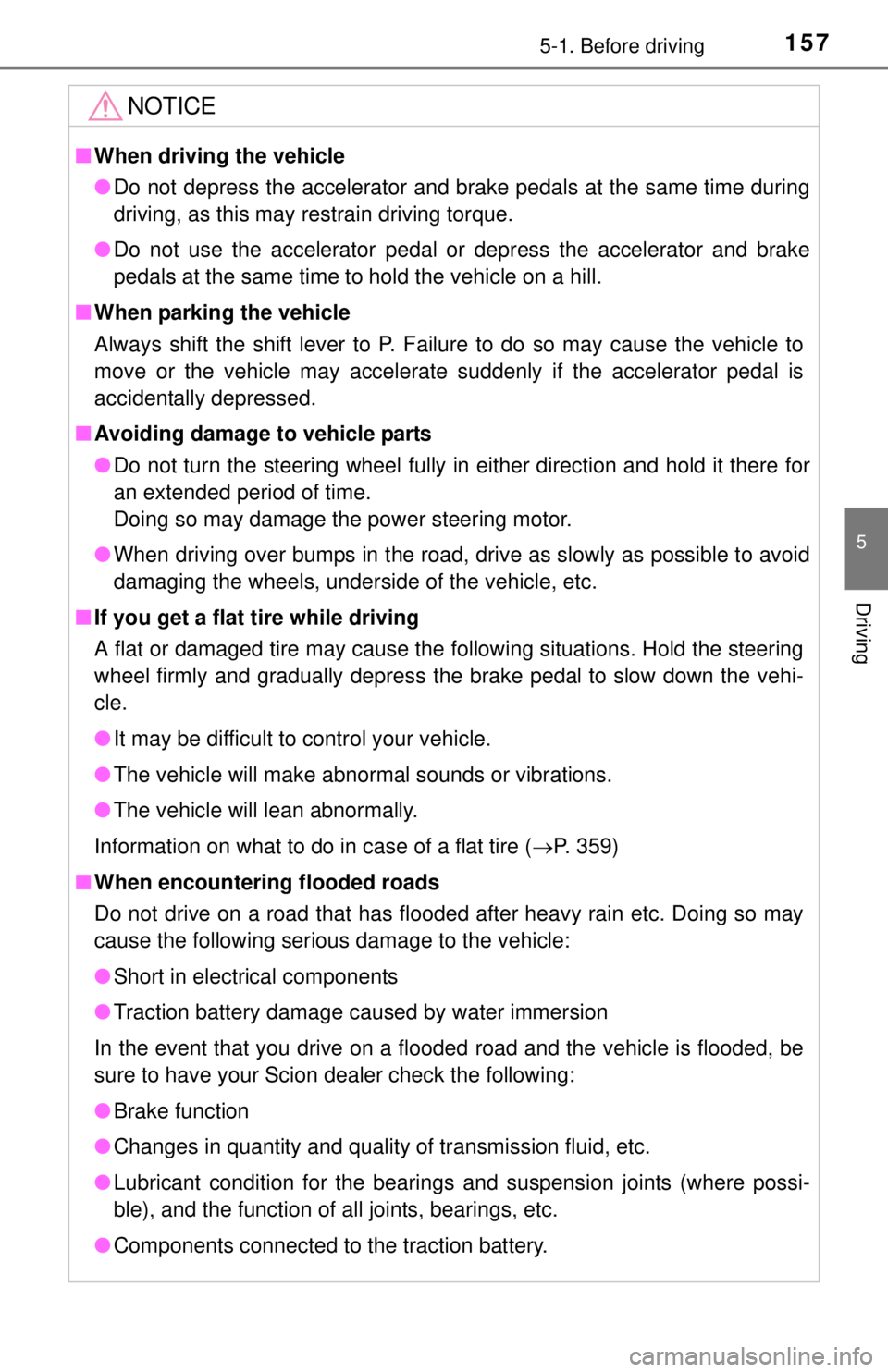
1575-1. Before driving
5
Driving
NOTICE
■When driving the vehicle
● Do not depress the accelerator and brake pedals at the same time during
driving, as this may restrain driving torque.
● Do not use the accelerator pedal or depress the accelerator and brake
pedals at the same time to hold the vehicle on a hill.
■ When parking the vehicle
Always shift the shift lever to P. Failure to do so may cause the vehicle to
move or the vehicle may accelerate suddenly if the accelerator pedal is
accidentally depressed.
■ Avoiding damage to vehicle parts
● Do not turn the steering wheel fully in either direction and hold it there for
an extended period of time.
Doing so may damage the power steering motor.
● When driving over bumps in the road, drive as slowly as possible to avoid
damaging the wheels, underside of the vehicle, etc.
■ If you get a flat tire while driving
A flat or damaged tire may cause the following situations. Hold the steering
wheel firmly and gradually depress the brake pedal to slow down the vehi-
cle.
● It may be difficult to control your vehicle.
● The vehicle will make abnormal sounds or vibrations.
● The vehicle will lean abnormally.
Information on what to do in case of a flat tire ( P. 359)
■ When encounterin g flooded roads
Do not drive on a road that has flooded after heavy rain etc. Doing so may
cause the following serious damage to the vehicle:
● Short in electrical components
● Traction battery damage caused by water immersion
In the event that you drive on a flooded road and the vehicle is flooded, be
sure to have your Scion dealer check the following:
● Brake function
● Changes in quantity and quality of transmission fluid, etc.
● Lubricant condition for the bearings and suspension joints (where possi-
ble), and the function of all joints, bearings, etc.
● Components connected to the traction battery.
Page 171 of 444
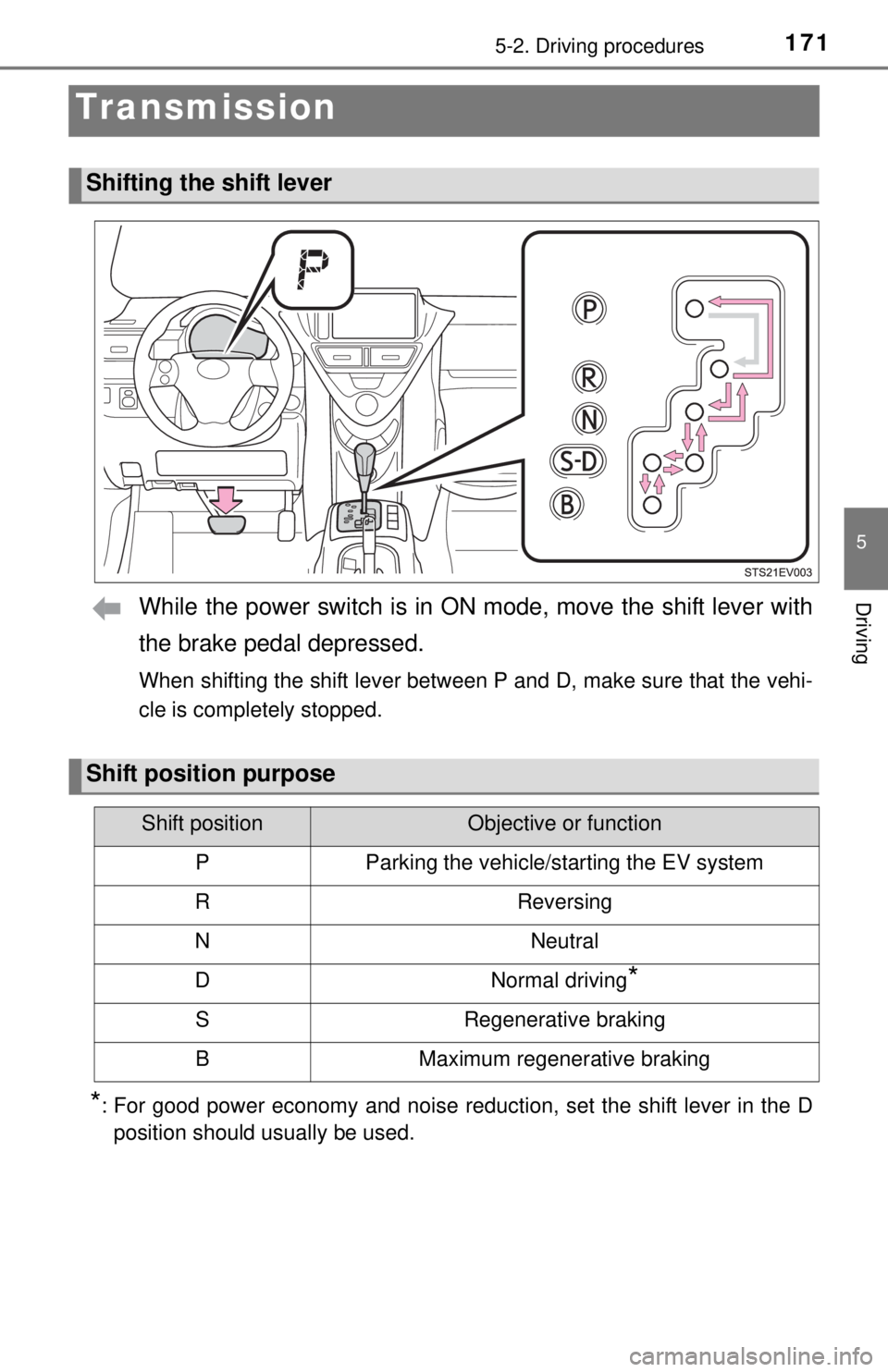
1715-2. Driving procedures
5
Driving
Transmission
While the power switch is in ON mode, move the shift lever with
the brake pedal depressed.
When shifting the shift lever between P and D, make sure that the vehi-
cle is completely stopped.
*: For good power economy and noise reduction, set the shift lever in the D position should usually be used.
Shifting the shift lever
Shift position purpose
Shift positionObjective or function
PParking the vehicle/starting the EV system
RReversing
NNeutral
DNormal driving*
SRegenerative braking
BMaximum regenerative braking
Page 257 of 444
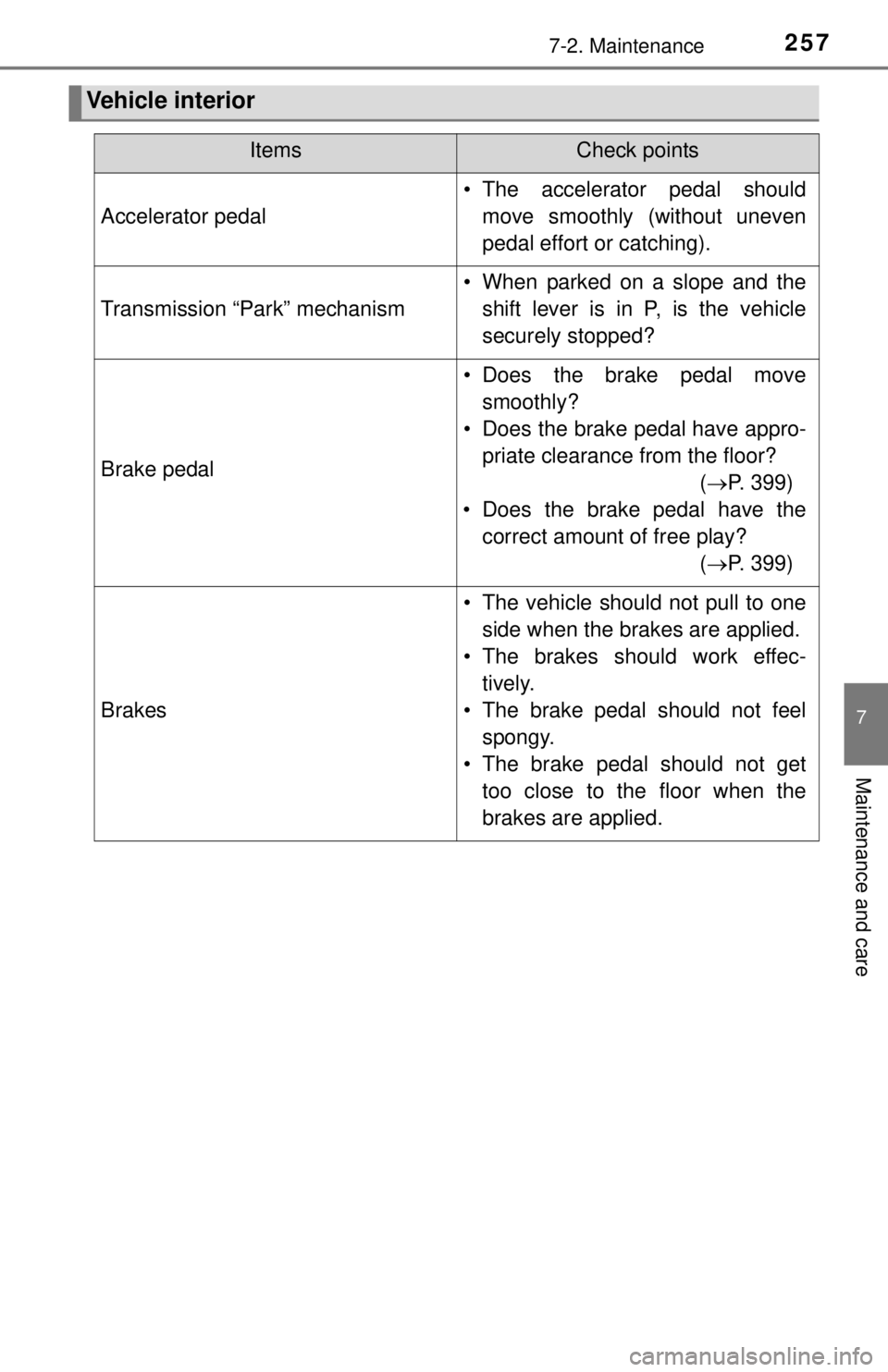
2577-2. Maintenance
7
Maintenance and care
Vehicle interior
ItemsCheck points
Accelerator pedal
• The accelerator pedal shouldmove smoothly (without uneven
pedal effort or catching).
Transmission “Park” mechanism
• When parked on a slope and theshift lever is in P, is the vehicle
securely stopped?
Brake pedal
• Does the brake pedal movesmoothly?
• Does the brake pedal have appro- priate clearance from the floor? (P. 399)
• Does the brake pedal have the correct amount of free play? (P. 399)
Brakes
• The vehicle should not pull to one
side when the brakes are applied.
• The brakes should work effec- tively.
• The brake pedal should not feel spongy.
• The brake pedal should not get too close to the floor when the
brakes are applied.
Page 330 of 444
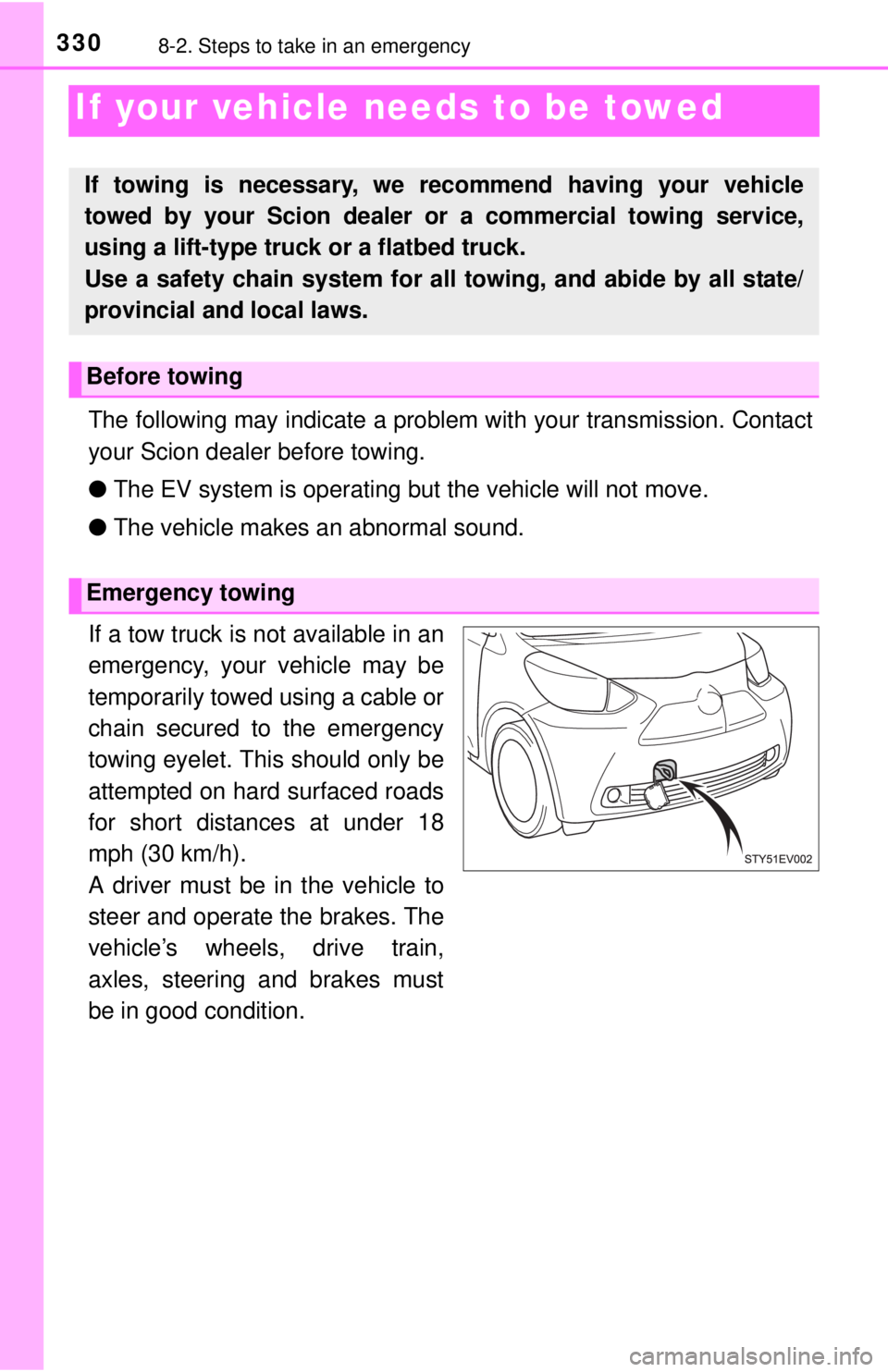
3308-2. Steps to take in an emergency
If your vehicle needs to be towed
The following may indicate a problem with your transmission. Contact
your Scion dealer before towing.
●The EV system is op erating but the vehicle will not move.
● The vehicle makes an abnormal sound.
If a tow truck is not available in an
emergency, your vehicle may be
temporarily towed using a cable or
chain secured to the emergency
towing eyelet. This should only be
attempted on hard surfaced roads
for short distances at under 18
mph (30 km/h).
A driver must be in the vehicle to
steer and operate the brakes. The
vehicle’s wheels, drive train,
axles, steering and brakes must
be in good condition.
If towing is necessary, we re commend having your vehicle
towed by your Scion dealer or a commercial towing service,
using a lift-type truc k or a flatbed truck.
Use a safety chain system for all towing, and abide by all state/
provincial and local laws.
Before towing
Emergency towing
Page 333 of 444
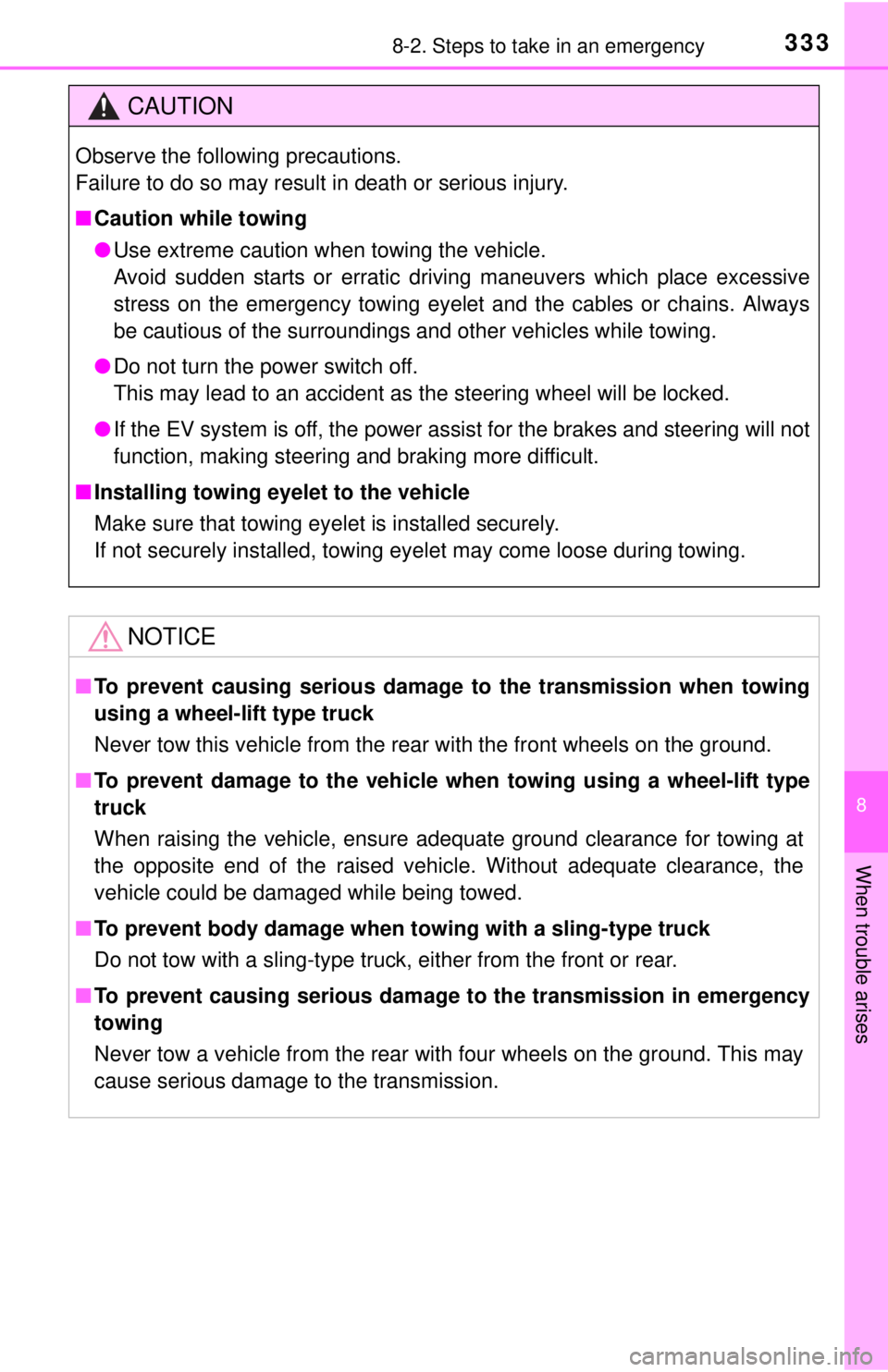
3338-2. Steps to take in an emergency
8
When trouble arises
CAUTION
Observe the following precautions.
Failure to do so may result in death or serious injury.
■Caution while towing
● Use extreme caution when towing the vehicle.
Avoid sudden starts or erratic driving maneuvers which place excessive
stress on the emergency towing eyelet and the cables or chains. Always
be cautious of the surroundings and other vehicles while towing.
● Do not turn the power switch off.
This may lead to an accident as the steering wheel will be locked.
● If the EV system is off, the power assist for the brakes and steering will not
function, making steering and braking more difficult.
■ Installing towing eyelet to the vehicle
Make sure that towing eyelet is installed securely.
If not securely installed, towing eyelet may come loose during towing.
NOTICE
■To prevent causing serious damage to the transmission when towing
using a wheel-lift type truck
Never tow this vehicle from the rear with the front wheels on the ground.
■ To prevent damage to the vehicle when towing using a wheel-lift type
truck
When raising the vehicle, ensure adequate ground clearance for towing at
the opposite end of the raised vehicle. Without adequate clearance, the
vehicle could be damaged while being towed.
■ To prevent body damage when towing with a sling-type truck
Do not tow with a sling-type truck, either from the front or rear.
■ To prevent causing serious damage to the transmission in emergency
towing
Never tow a vehicle from the rear with four wheels on the ground. This may
cause serious damage to the transmission.
Page 399 of 444
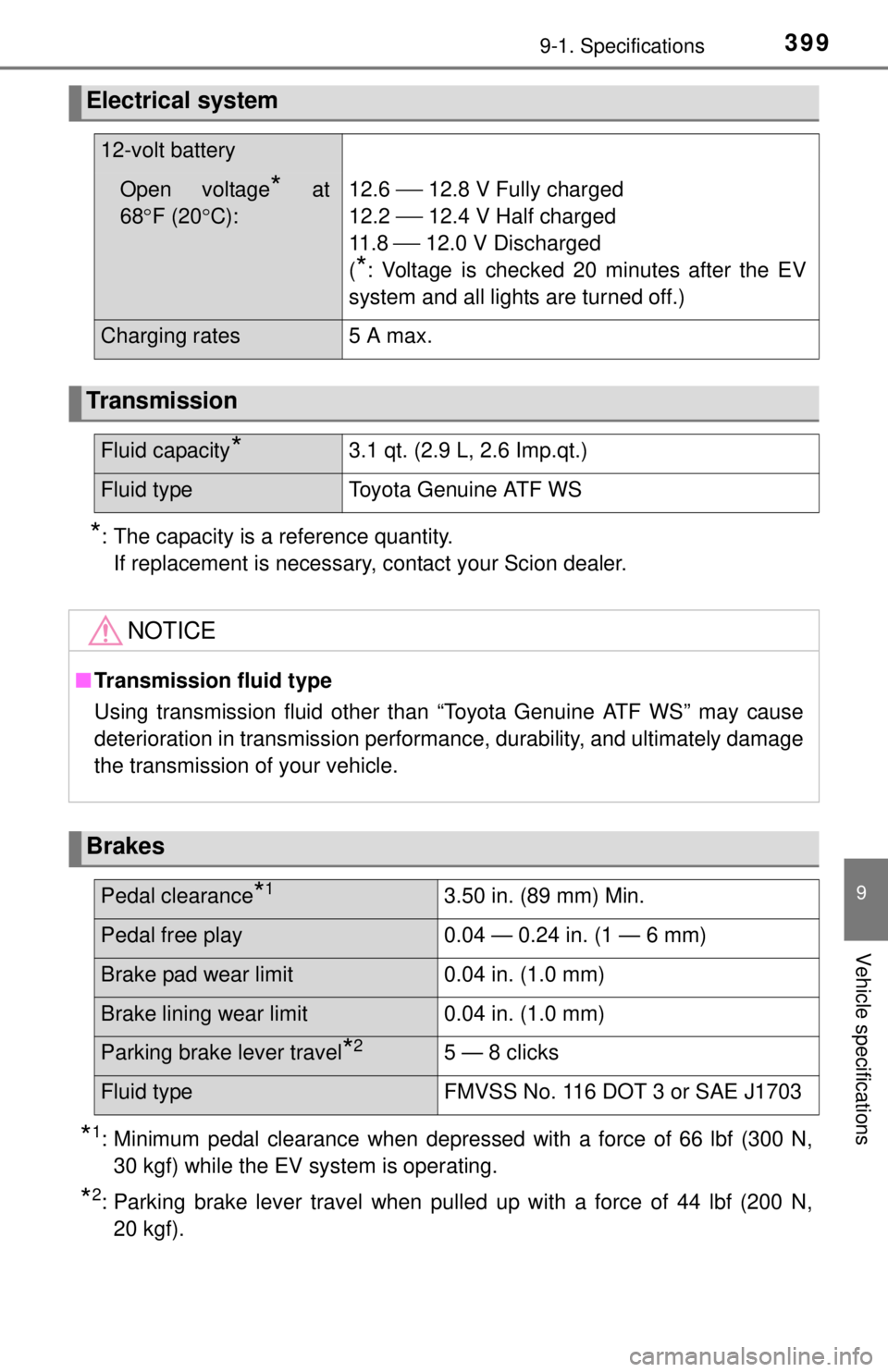
3999-1. Specifications
9
Vehicle specifications
*: The capacity is a reference quantity. If replacement is necessary, contact your Scion dealer.
*1: Minimum pedal clearance when depressed with a force of 66 lbf (300 N,30 kgf) while the EV system is operating.
*2: Parking brake lever travel when pulled up with a force of 44 lbf (200 N,20 kgf).
Electrical system
12-volt battery
Open voltage* at
68 F (20 C):12.6 12.8 V Fully charged
12.2
12.4 V Half charged
11 . 8
12.0 V Discharged
(
*: Voltage is checked 20 minutes after the EV
system and all lights are turned off.)
Charging rates5 A max.
Transmission
Fluid capacity*3.1 qt. (2.9 L, 2.6 Imp.qt.)
Fluid typeToyota Genuine ATF WS
NOTICE
■ Transmission fluid type
Using transmission fluid other than “Toyota Genuine ATF WS” may cause
deterioration in transmission performance, durability, and ultimately damage
the transmission of your vehicle.
Brakes
Pedal clearance*13.50 in. (89 mm) Min.
Pedal free play0.04 — 0.24 in. (1 — 6 mm)
Brake pad wear limit0.04 in. (1.0 mm)
Brake lining wear limit0.04 in. (1.0 mm)
Parking brake lever travel*25 — 8 clicks
Fluid typeFMVSS No. 116 DOT 3 or SAE J1703
Page 433 of 444
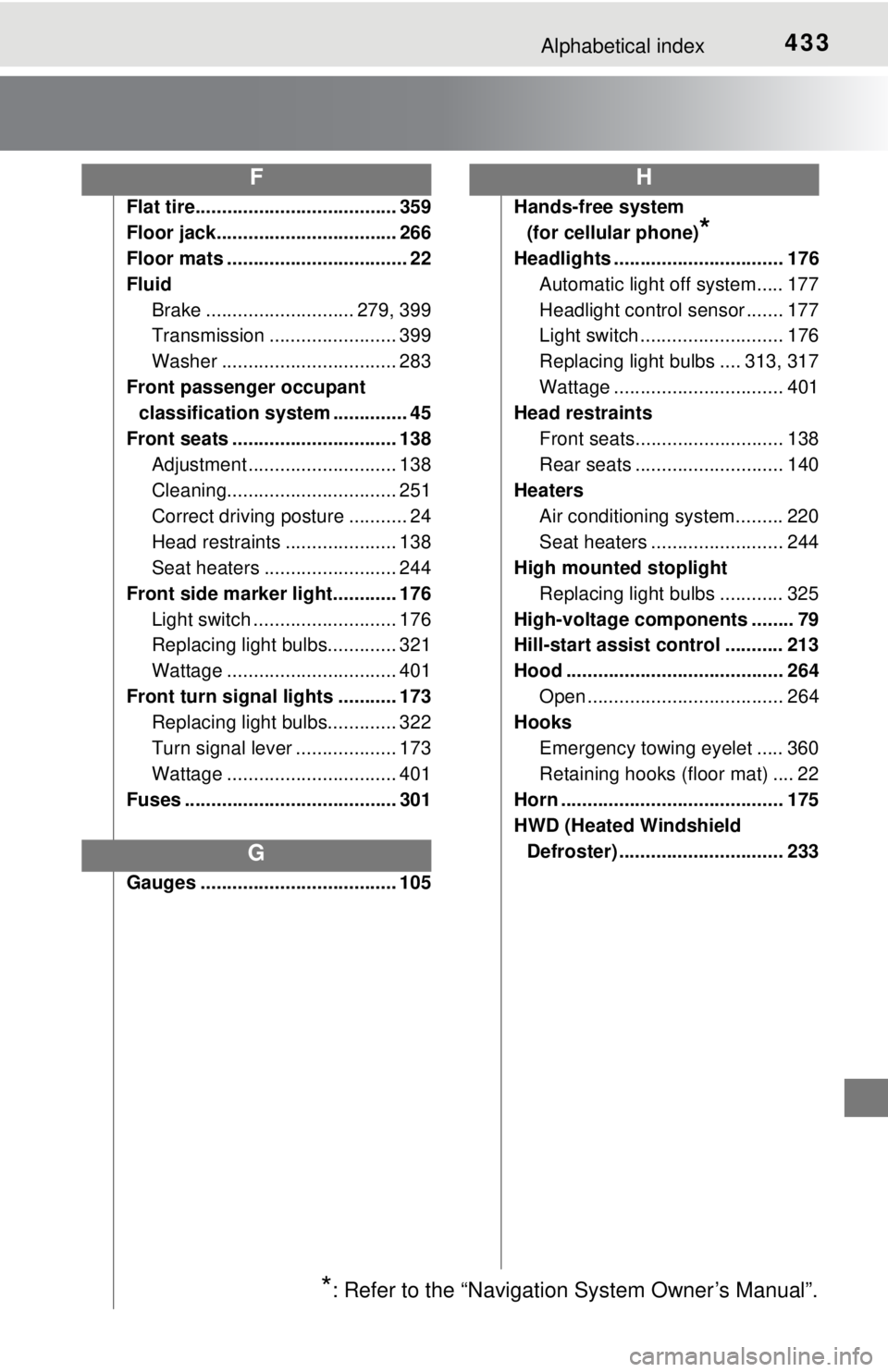
433Alphabetical index
Flat tire...................................... 359
Floor jack.................................. 266
Floor mats .................................. 22
FluidBrake ............................ 279, 399
Transmission ........................ 399
Washer ................................. 283
Front passenger occupant classification system .............. 45
Front seats ............................... 138 Adjustment ............................ 138
Cleaning................................ 251
Correct driving posture ........... 24
Head restraints ..................... 138
Seat heaters ......................... 244
Front side marker light............ 176 Light switch ........................... 176
Replacing light bulbs............. 321
Wattage ................................ 401
Front turn signal lights ........... 173 Replacing light bulbs............. 322
Turn signal lever ................... 173
Wattage ................................ 401
Fuses ........................................ 301
Gauges ..................................... 105 Hands-free system
(for cellular phone)
*
Headlights ................................ 176
Automatic light off system..... 177
Headlight control sensor ....... 177
Light switch ........................... 176
Replacing light bulbs .... 313, 317
Wattage ................................ 401
Head restraints
Front seats............................ 138
Rear seats ............................ 140
Heaters
Air conditioning system......... 220
Seat heaters ......................... 244
High mounted stoplight
Replacing light bulbs ............ 325
High-voltage components ........ 79
Hill-start assist control ........... 213
Hood ......................................... 264 Open ..................................... 264
Hooks
Emergency towing eyelet ..... 360
Retaining hooks (floor mat) .... 22
Horn .......................................... 175
HWD (Heated Windshield
Defroster) ............................... 233
F
G
H
*: Refer to the “Navigation System Owner’s Manual”.